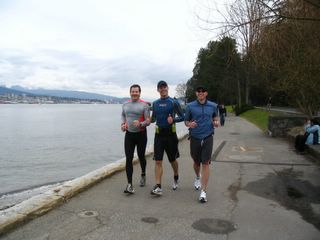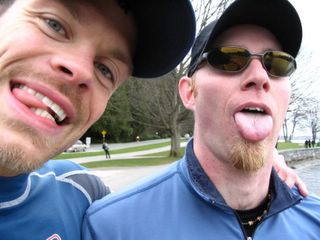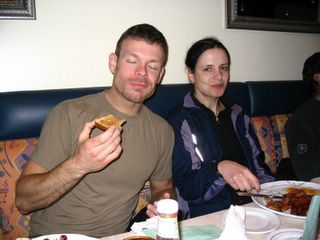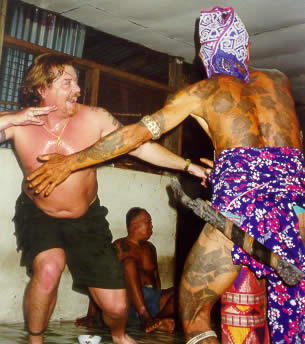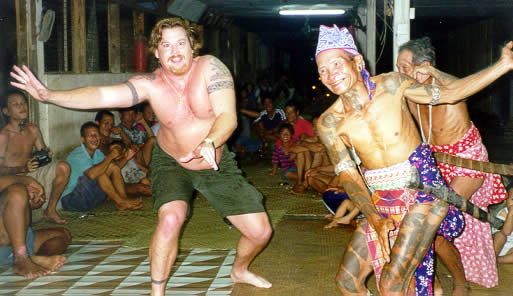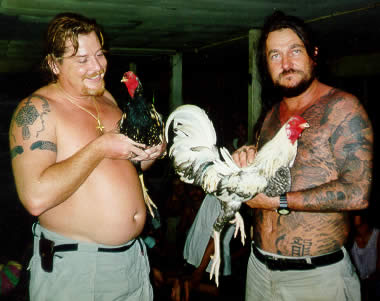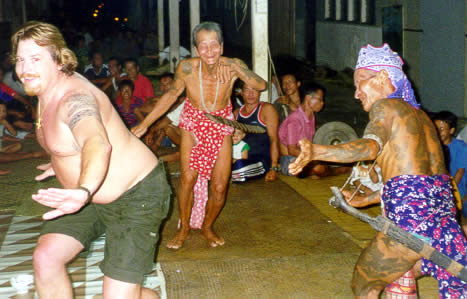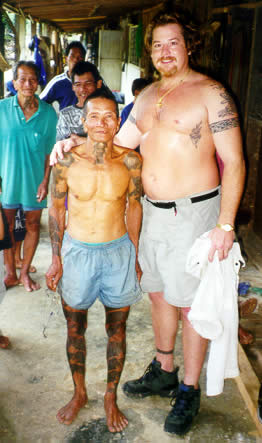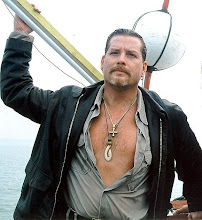Well, I went for my Max VO2 Test and my Hydrostatic Body Fat Test today.
Well…
Well...
Where to begin?
Let me initially evade the hard facts by profusely thanking the staff at the John Buchanan Exercise Science Laboratory at The University of British Columbia, particularly Rob Langill. Rob was a font of information and everyone at the Lab went out of their way to accommodate me and the rest of the gang from the Running Room Marathon Clinic and help us out in every way they could.
Down to brass tacks. The test this afternoon was one of those, good news and bad news scenarios. And there is not really any way I can sugarcoat or finesse this.
The bad news is so bad, it’s actually good. Kind of like the long slow distance runs on Sunday where I berate my charges into slowing down and then tell them in a very Zen-like voice, “Sometimes in order to run fast, first you must run slow.”
I am so fat, that I only have room for improvement. How fat am I? Not so fast, my little chickens!
First off, I owe a HUGE apology to Ron and Steph and Rachel for giving them a hard time about having difficulty achieving their maximum heart rate. After they did the test, they kept up this strange muttering and mumbling about the treadmill and the mask and how hard it was to concentrate and focus and I, I, in all of my graciousness and sweetness and in my most diplomatic manner for which I am famous, basically accused them of being a bunch of weak little sissy scaredy-cat panty-waist girls… Much like myself as it turned out.
I never really got a good idea from Ron and Steph and Rachel how the lab was set up. First off, the treadmill is halfway to the
FREAKIN’ ceiling, guys! The treadmill is elevated. As in elevator to get onto it! It’s thirty inches off the freakin’ ground. I too was afraid I was going to get shot off the end of it when my heart maxed out.
Second, the mask that you have to wear over your face to measure your oxygen intake and carbon-dioxide output, wasn’t suspended very well. As Rob said to me, figure out a better way to do it, Vince and it’s a million dollar idea. I may have to form a Max VO2 Skunkworks with Michael, Sean and Warren in a garage. Because there definitely has to be a better way to do this without having to resort to running in a sealed chamber. The mask was wired to a pole and it pulled my head to one side as I ran and I couldn’t move my head up or down which had major consequences at the end of the test.
I warmed up by running on the treadmill and chatting with Rob. Rob asked about my running background and training and I regaled him with tall tales of my misadventures. I had no sooner mentioned the word, “kilt”, than Rob had blurted out that he had read all about my exploits. “I know you! I read about you. You’re the guy who ran the ultramarathon in Dayton Boots, didn’t you.”
“One and the same,” I said proudly. “And a few marathons for good measure.”
“Man, that’s just nuts.” And with that Rob said he was ready to get started.
Rob started me out at five miles an hour and ramped up the speed every minute. After eight minutes I was running nine miles an hour. Every minute after that, Rob increased the elevation of the treadmill by two percent. The first ten minutes was relatively easy. It was hard, but not that much different than running on any treadmill. What made the mask so annoying, other than the sweat running into my eyes, was that I could not properly align my head. I couldn’t run straight without the mask tugging my head to one side. At three quarters it wasn’t so bad, but nearing my maximum heart rate it became more and more annoying.
Also, as the speed stayed the same, but the elevation of the treadmill changed, I couldn’t adjust my head to compensate for the fact that I was now running at full speed up a slight incline. And at the end, the incline wasn’t so slight. It was 6%. It was a hill in other words. So I felt like I was horse galloping along with my head held up in a halter. I couldn’t lower my head or my chin to adjust for the incline, as you would during a hill workout. I couldn't, "dig in" to the hill like I usually do when working close to my maximum heart rate.
And finally, and once again I throw myself at the feet of Ron, Steph and Rachel in abject apologies, as I neared my maximum, I was ever mindful and cognizant of the fact that I was going full tilt on a treadmill that was several feet in the air and I was in danger of momentarily collapsing and shooting off the end like a great sodden projectile. Near the end of the test, as my form began to falter and my running architecture began to break down, I literally bailed out. I grabbed the railings and vaulted off the treadmill to rest my weary feet on either side of the grey snake whizzing by underneath me.
The sweat poured off me and Rob slowed the treadmill down to five miles an hour to allow me to cool down. He played with the machine and went to the computer to get his readings. Before I would know the results, Rob weighed me in the next room in the “tank”. And the “tank” is literally a big tank filled with warm water and a scale that looks like a giant playground swing. You have to sit in it. You lower your head beneath the surface and exhale as much of the air in your lungs as you can. And this takes place mere moments after you have been gasping what seemed like your last breath on the treadmill. Those guys at Buchanan are sick bastards, let me tell you. This is what they do for a living.
To get an accurate reading is not as easy as you might think. To begin with, your body treasures every morsel of oxygen that you have in your lungs. Especially when your head is under water. It’s hard to squeeze out the last few bubbles. But Rob got identical back-to-back readings and let me emerge from the tank. As I dried off and changed, he went to make his calculations. Rob said he went into Phys Ed to get out of doing math and in the end, a huge part of his job is crunching numbers.
So here is the part you’ve been waiting for, the numbers.
My Max heart rate reading was 185. But because of all the training I have done with heart rate monitors over the years, I know that this number is inaccurate. Rob says from his experience that the equipment and the mask and the treadmill and the artificiality of the procedure usually lops what he figures is about 5-7 heart beats off of what would be most people’s true maximum heart rate. In my case, based on numbers I’ve seen, I know my true maximum heart rate is in the neighbourhood of 200-205. Also, if you look at my chart, you can see that my heart rate hasn’t flattened out. It was climbing when I bailed out of my burning plane and pulled the ripcord. What a pussy, Hemingson!
My Lactate Threshold is given as 159-164. Interestingly, my best tempo training runs are the ones I do at 162-164. When I let myself get lured by the pretty girls up to 168-172, I get a little burnt around the edges. Getting up that high for me has to be saved for races, not training.
My Max VO2 is 52.4. If you extrapolate that number out to what my maximum heart rate is more likely to be, my Max VO2 is probably in the area of 54-55. Anything over 48 for men over the age of 40 is considered "superior", ie the highest end of the scale.
Now here comes the bad news. My bathroom scale is
Gar-Baj 196 my ass! I tip the scales, real accurate scales that it, at 203.3 pounds! 92.3 kilos! My body fat percentage is a staggering 22%. In my worst-case scenario, I thought it would be around 16%. At 12% body fat I would tip the scales at 180 pounds.
Rob attempted to ease my pain by saying that most healthy men are between 16-20%. Hah! Crap! I am a freakin' Graf Zepplin. I am the Great White Buffalo of Borneo, and if not the Buffalo, a pretty damn big horse! However, losing ten-twelve per cent body fat, also means getting ten-twelve percent faster. It certainly explains why I could run a 36 minute 10K in my twenties when I weighed 185 pounds. And why I'm not now.
BUT. There
IS a but to all this. Here is where the numbers gets interesting. Because numbers are meant to be played around with, shuffled and crunched until you get all the juice and data and information you can squeeze out of them. The bad news here is so bad, it actually becomes, paradoxically and perversely, now get this, kids at home,
GOOD news.
Max VO2 is a function of oxygen utilized as a percentage of bodyweight. Based on the numbers I produced today, if I weighed 180 pounds at 12% body fat, my Max VO2 value would shoot up to a quite impressive 58.1. And then if you factor in my true maximum heart rate and look at my being able to get down to 10% body fat, then Rob said it was completely realistic for me to look at targeting a Max VO2 of 60-65.
Two world-class Sub 2:11 marathoners by the names of Derek "Deke" Clayton and one Frank Shorter had respective Max VO2s of 68 and 71. I, folks, can take solace and not a little inspiration from that. And there is more.
Max VO2 numbers in the 65 range? 10-12% body fat? 10-12% faster?
THAT folks, puts me in the three-hour marathon range! So if you are a cock-eyed optimist such as is yours truly, the disastrous numbers I came up with, actually, when you look at them the right way,
DO HAVE a silver lining.
Come this time next year, as I prepare to race Boston, I will be slicker than snot on a doorknob and greased lightning in the second-half of the marathon. Heartbreak Hills be damned!
 Lactate Threshold
Lactate Threshold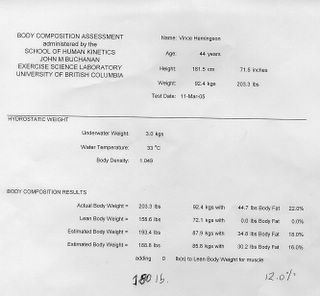 Body Fat % - MAX FAT!
Body Fat % - MAX FAT! Max VO2 - Heart Rate/VO2
Max VO2 - Heart Rate/VO2



